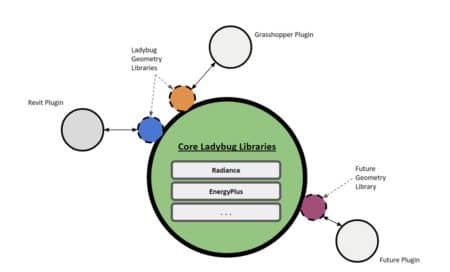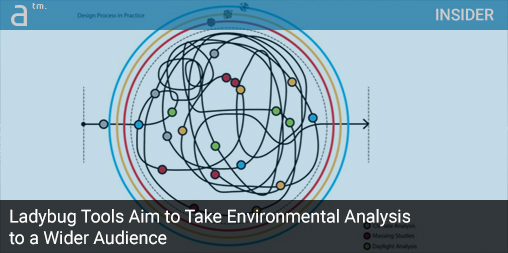Continued from page 1
(Mostapha) It depends on the type of study you are trying to run and it depends on how much you want to pay. In most cases, if you use 100 CPUs, the results are going to come much faster than using 8. I can’t give an exact number but I can tell you that it is going to be several times faster than doing these simulations on the desktop.
For example, the engineer can set up the workflow for a specific project, deploy it to Pollination Cloud, and tell the architect to just send over the data once they are done. It’s about sharing data and not sharing 3D models.
But here is the key, it is not just about running the simulations faster, it is also about developing the simulations workflows faster and collaborating on developing those workflows in a more optimal way.
You are talking about getting people together to discuss these simulations, about working with engineers and bringing them into the process…
Right. Right now it takes so long for people to collaborate and run these simulations. We are trying to address the collaboration issue with Pollination. For example, the engineer can set up the workflow for a specific project, deploy it to Pollination Cloud, and tell the architect to just send over the data once they are done. It’s about sharing data and not sharing 3D models.
So you said earlier how much you want to pay for, in reference to using Pollination Cloud, the web service. Recap for me how your company generates revenue.
(Chris) Well, the core libraries will always be free; the Grasshopper plugins will always be free. You pay for access to the platform for collaboration, reliability, and scalability. You also have to pay more if you want to keep your workflows private. Again, very similar to why people pay for GitHub when it’s free for open-source projects.
Well, I remember Chris that some of your work at Payette used HumanUI to develop more accessible interfaces for people who don’t know visual scripting. What about adding those levels of user interface engagement?
We absolutely plan to support more traditional interfaces that don’t have the learning curve of visual scripting. However, if people are looking for a shortcut to bypass learning curves that our community members have gone through, then this may be an area where we would charge money.
Our philosophy is always that, if you are willing to sit down, become an expert, and teach yourself about the advanced parts of the software, then you should never hit a paywall.
Our philosophy is always that, if you are willing to sit down, become an expert, and teach yourself about the advanced parts of the software, then you should never hit a paywall. But, if you want to access advanced capabilities without putting in as much time to learn about them, this might come with a price tag.
I want to ask about your community in a bit, but first, I want to talk about how the [+] Project and Pollination Cloud can get your tools into other places, get your tools into other tools.
(Mostapha) The [+] Project was about making the codebase more accessible, getting it out of Grasshopper, getting it ready for the cloud, and making it easier to maintain. And one of the issues with it being in Grasshopper is that it doesn’t scale well. For heavy lifting work, we needed to take it outside of Grasshopper. Grasshopper is single-threaded; it doesn’t use multithreading; it’s not easy to scale up.
And the other thing about this effort was making the code much easier to test and maintain, in a Continuous Integration and Continuous Delivery (CI/CD) model, using automated processes to test and deploy code, things that are not easy or even possible to do when all your code is inside a tool like Grasshopper.
While Grasshopper and Rhino are clearly kings of the computational design tools world, it sounds like you can now get your tools into other AAD (algorithms-aided design) platforms, like Bentley Generative Components or Vectorworks’ Marionette.
It is. We have endpoints that you can call from any of these tools. We have SDKs in different languages. Even if you don’t want to use our cloud solutions, we have a library that enables you to utilize your own geometry layer, and the rest of the tools can run regardless of the platform you are on. (see image below).

The Ladybug Core Libraries are accessible via SDKs in multiple languages and can support future plugin support through Ladybug Geometry libraries and future libraries. (image: Ladybug Tools LLC / Architosh. All rights reserved.)
It sounds like you are building up a good API or that strong trunk in the tree analogy from which to distribute and democratize these tools.
(Chris) Yes, and we take a lot of inspiration from other software that we feel has been developed correctly like Rhino itself. They have this strong API, this sturdy and robust foundation and, as a result, they have a thriving and expanding ecosystem of plugins and applications around it.
And speaking of expansion, when is Pollination Cloud going to be ready? And what are your plans for expanding your tools—any more bugs?
(Mostapha) The endpoints are planned for the end of the first quarter of 2020. And then in the second quarter of 2020, we will release plugins for Grasshopper. We will support daylight analysis and energy analysis first, and then we will decide if we add comfort or CFD to Pollination Cloud next.
(Chris) We are interested in inserting a couple of new insects in the future.
Getting back to the community…how big is your user base, and has your user base changed?
(Chris) We have approximately 60,000 unique email addresses in our user base and a few thousand in our active community. Historically, we had many more architects and consultants than engineers, but this has changed. People in the engineering community have been climbing the learning curve of Grasshopper now that many of them see the flexibility it affords with designing HVAC systems. We have data from a survey with 200 responses from the most active users in our community. 40 percent of them were in architecture, 33 percent were environmental consultants, and the rest were engineers.

Ladybug community by user types, with Architecture users, still dominating but engineering professionals increasingly coming on board as they realize the benefits of the Grasshopper environment and the many benefits of tools like Ladybug and Honeybee. (image: Ladybug Tools LLC / Architosh. All rights reserved.)
This is all very fascinating, and I wish you both the best of luck with Ladybug Tools and the new initiatives.
(Mostapha and Chris) Thank you.
Readers can learn more about Ladybug Tools by visiting their website here.
Image Credits
Format equates to “party with copyright” / “party with reserved rights of use.” (eg: image: Ladybug Tools LLC / Architosh. All rights reserved.)
Title image credit: Ladybug Tools LLC / Architosh. All rights reserved.




Reader Comments
[…] gratuito di Clex Academy [18.04] AutoCAD 2021 [20.46] Documentari su architettura e design [24.28] Ladybug Tools [33.31] Approccio al BIM [36.44] Un ponte verde a Lisbona [43.37] […]
Comments are closed.